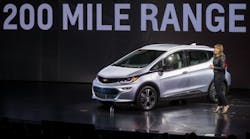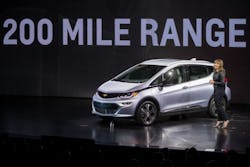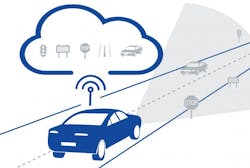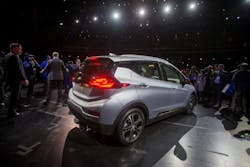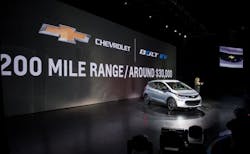Typically, the rule of thumb is that trucking technological developments lag about a decade or so behind those of automobiles.
Not this time around – especially where autonomous vehicle development is coA speech given by Mary Barra (seen at right introducing the 2017 Bolt EV; we'll get to that a little later), the chairman and CEO of General Motors, at CES 2016 (FYI: she got tapped to be the automaker’s chairman just this week) crystallized that thought for me as she discussed a variety of light vehicle trends that bear directly on the heavy truck side of the market as well.
“I have no doubt that the automotive industry will change more in the next five to 10 years than it has in the last 50,” she said. “The convergence of connectivity, vehicle electrification, and evolving customer needs demand new solutions.”
She noted that broader “societal trends” such as urbanization and sustainability are going to drive a lot of this change, as well as new technological developments at improving safety, fuel economy, and creating autonomous vehicles.
Barra noted, however, that automobiles originally started out as a “boutique business,” only available to the very wealthy. “Not until we were building affordable cars on a large scale that the automobile changed everyone’s life,” she said.
The same story applies to electricity – something else Barra said we take for granted – but when first introduced, was only available to the elite. Back during electricity’s formative years, having a single light bulb was seen “as a luxury,” she said, “but today electricity powers our lives.”
The same holds for “connectivity,” another facet of daily life taken for granted as well, Barra pointed out (though one with a rising risk profile we rarely appreciate).
“But the first smart phones were available only to those who could afford them,” she said. “But now, just last year – only 12 years after Blackberry came to the U.S. – some 1.2 billion smart phones were sold.”
Connectivity is now so ubiquitous, it’s now also expected to exist ready-to-go in our vehicles as well – cars as well as commercial trucks.
Indeed, Barra said that by the end of this year, GM will have some 12 million connected vehicles on the road all around the world – with 4 million of them in the U.S. and Canada alone.
So how will these trends affect truck technology? Let’s start with autonomous vehicle systems.Take a new effort to use “crowd-sourced” real-time data collected by GM’s OnStar system and then deploying it into real-time mapping technology developed by Mobileye – resulting in more precise localization and high-definition lane data to support self-driving vehicle.
This is one of GM’s latest ventures, using Mobileye’s Road Experience Management (REM) technology to create a continuously updated road map for vehicles to navigate themselves by.
“Cameras are the most natural sensors for creating maps because they are already available in most new car models as part of the trend toward growing driver assistance deployment,” noted Amnon Shashua, co-founder, chairman and chief technical officer of Mobileye, in a statement. “Creating and updating maps using on-board camera technology supplies the missing link between on-board sensing and the requirement for full redundancy to enable safe autonomous driving.”
Shashua added that Mobileye expects to eventually achieve “localization” with an accuracy of about 10 centimeters compared with today’s GPS, which can pinpoint to about 10 meters.
GM has collaborated on camera technology with Mobileye for a decade, beginning with lane departure warning systems launched in 2007, and this venture is just the latest step in that partnership, noted Mark Reuss, GM’s executive VP for product development, purchasing and supply chain, in a statement.
“GM is committed to bringing semi-autonomous and fully autonomous vehicles to our customers, and this technology will be a critical enabler to getting us there,” Reuss added. “We are planning to explore the integration of REM into existing GM program launches sometime later this year.”Of course, there’s the whole question of whether people will buy such self-driving cars to start with. Yet GM is planning a way around that particular conundrum through a new $500 million investment in ride-sharing service provide Lyft.
This new long-term strategic alliance is designed to create an integrated network of on-demand autonomous vehicles in the U.S., noted Dan Ammann, GM’s president.
“We see the future of personal mobility as connected, seamless and autonomous,” he explained in a statement. “With GM and Lyft working together, we believe we can successfully implement this vision more rapidly.”
Here are few key elements of this deal, and no doubt you can see some of the potential implications for trucking (self-driving rental trucks anyone?):
- The joint development of an on-demand autonomous vehicles network that combines GM’s autonomous technology know-how and Lyft’s capabilities in providing a broad choice of ride-sharing services.
- Beginning immediately, GM will become a preferred provider of short-term use vehicles to Lyft drivers through rental hubs in various cities in the U.S.
- Lyft drivers and customers will have access to GM’s wide portfolio of cars and OnStar services to create a “richer” ride-sharing experience for both driver and passenger (technology that will, of course, help enable the vehicle to drive itself at some point).
In terms of future mobility, Barra thinks the electric vehicle is going to play a more significant role – especially as populations become more urbanized and more sustainability-focused. That’s one reason why GM chose CES 2016 to formally introduce the 2017 Bolt EV, which will go into production by the end of 2016.
The Bolt EV ostensibly offers 200 miles of range on a full charge and features those “advanced connectivity technologies” so desired by the younger generations.“It was less than a year ago that we revealed the Bolt EV concept and promised to deliver a long-range electric vehicle attainable by the masses,” Barra noted. “The Bolt EV is capable of using the latest mobile app technology to enable car sharing, advanced GPS routing and 'gamification' (meaning you can play video games in it), all designed to enhance the ownership experience now and into the future.”
She added that the Bolt EV’s connectivity provides “smart, personalized solutions” for better vehicle operating management. For example, in the future an accurate driving range projection will be based on the time of day, typography, weather and the owner’s driving habits.
Bluetooth low-energy – designed specifically for the Bolt EV to minimize energy draw – connects a smart phone to the car while the owner approaches the vehicle, so it’s all synched up and ready to go without any action by the driver.
Many of the Bolt EV’s driver-focused technologies are supported by OnStar 4G LTE, Barra noted, which turns the Bolt EV into a Wi-Fi hotspot, giving owners easier access to apps and services via a high-speed wireless connection.
Being built at GM’s Orion assembly facility, located near Detroit, MI, Barra said the Bolt EV will cost roughly $30,000 after federal tax credits are applied, can be recharged to 80% power in 60 minutes (it takes overnight charging to get it to 100%) and can be serviced at any of GM’s 3,000 Chevrolet dealerships.
Now we wait and see what the driving public thinks of this new “more affordable” EV as GM describes it – and whether all the connectivity goodies inside will convince them to buy it.
